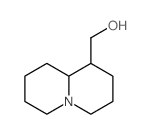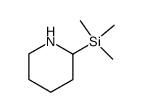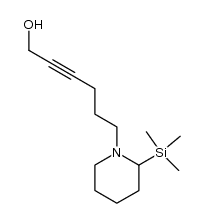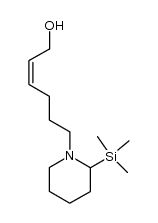10159-79-2
| Name | 2,3,4,6,7,8,9,9a-octahydro-1H-quinolizin-1-ylmethanol |
|---|---|
| Synonyms |
Octahydro-2H-Quinolizine-1-Methanol
2H-Quinolizine-1-methanol,octahydro-,(1R-trans) (+-)-Epilupinin Octahydro-2H-quinolizin-1-ylmethanol UPCMLD-DP047 1-Hydroxymethylchinalisidin <14C>-Lupinin (1R,9aR)-1-(Octahydroquinolizin-1-yl)methanol DL-1-Epilupinin octahydroquinolizin-1-yl-methanol 2H-Quinolizine-1-methanol,octahydro-,(1S-cis) 1-Epilupinine |
| Density | 1.04 g/cm3 |
|---|---|
| Boiling Point | 245ºC at 760 mmHg |
| Melting Point | 68-70ºC |
| Molecular Formula | C10H19NO |
| Molecular Weight | 169.26400 |
| Flash Point | 99.1ºC |
| Exact Mass | 169.14700 |
| PSA | 23.47000 |
| LogP | 1.18110 |
| Vapour Pressure | 0.00489mmHg at 25°C |
| Index of Refraction | 1.525 |
Synonym:Lupinin Section 2 - COMPOSITION, INFORMATION ON INGREDIENTS
Risk Phrases: 23/24/25 Section 3 - HAZARDS IDENTIFICATION EMERGENCY OVERVIEW
Toxic by inhalation, in contact with skin and if swallowed. Potential Health Effects Eye: May cause eye irritation. Skin: May cause skin irritation. Toxic in contact with skin. Ingestion: May cause irritation of the digestive tract. May cause central nervous system depression, characterized by excitement, followed by headache, dizziness, drowsiness, and nausea. Advanced stages may cause collapse, unconsciousness, coma and possible death due to respiratory failure. May cause tingling and numbness of the extremities. Continued exposure may result in muscular weakness, difficulty in maintaining balance, and clumsiness in walking and the use of hands. Toxic if swallowed. Inhalation: May cause respiratory tract irritation. Toxic if inhaled. Chronic: Not available. Section 4 - FIRST AID MEASURES Eyes: Immediately flush eyes with plenty of water for at least 15 minutes, occasionally lifting the upper and lower eyelids. Get medical aid immediately. Skin: Get medical aid immediately. Immediately flush skin with plenty of water for at least 15 minutes while removing contaminated clothing and shoes. Ingestion: Get medical aid immediately. Wash mouth out with water. Inhalation: Get medical aid immediately. Remove from exposure and move to fresh air immediately. If not breathing, give artificial respiration. If breathing is difficult, give oxygen. Notes to Physician: Treat symptomatically and supportively. Section 5 - FIRE FIGHTING MEASURES General Information: As in any fire, wear a self-contained breathing apparatus in pressure-demand, MSHA/NIOSH (approved or equivalent), and full protective gear. Extinguishing Media: Use water spray, dry chemical, carbon dioxide, or chemical foam. Section 6 - ACCIDENTAL RELEASE MEASURES General Information: Use proper personal protective equipment as indicated in Section 8. Spills/Leaks: Vacuum or sweep up material and place into a suitable disposal container. Section 7 - HANDLING and STORAGE Handling: Do not breathe dust, vapor, mist, or gas. Do not get in eyes, on skin, or on clothing. Use only in a chemical fume hood. Storage: Store in a cool, dry place. Store in a tightly closed container. Section 8 - EXPOSURE CONTROLS, PERSONAL PROTECTION Engineering Controls: Use adequate ventilation to keep airborne concentrations low. Exposure Limits CAS# 10159-79-2: Personal Protective Equipment Eyes: Not available. Skin: Wear appropriate protective gloves to prevent skin exposure. Clothing: Wear appropriate protective clothing to prevent skin exposure. Respirators: Follow the OSHA respirator regulations found in 29 CFR 1910.134 or European Standard EN 149. Use a NIOSH/MSHA or European Standard EN 149 approved respirator if exposure limits are exceeded or if irritation or other symptoms are experienced. Section 9 - PHYSICAL AND CHEMICAL PROPERTIES Physical State: Solid Color: white Odor: Not available. pH: Not available. Vapor Pressure: Not available. Viscosity: Not available. Boiling Point: 269 - 270 deg C @755mmHg Freezing/Melting Point: 68 - 70 deg C Autoignition Temperature: Not available. Flash Point: Not available. Explosion Limits, lower: Not available. Explosion Limits, upper: Not available. Decomposition Temperature: Not available. Solubility in water: Soluble. Specific Gravity/Density: Molecular Formula: C10H19NO Molecular Weight: 169 Section 10 - STABILITY AND REACTIVITY Chemical Stability: Not available. Conditions to Avoid: Incompatible materials. Incompatibilities with Other Materials: Oxidizing agents. Hazardous Decomposition Products: Hydrogen cyanide, nitrogen oxides, carbon monoxide, carbon dioxide, acrid smoke and fumes. Hazardous Polymerization: Has not been reported. Section 11 - TOXICOLOGICAL INFORMATION RTECS#: CAS# 10159-79-2 unlisted. LD50/LC50: Not available. Carcinogenicity: Octahydro-2H-quinolizin-1-ylmethanol - Not listed by ACGIH, IARC, or NTP. Section 12 - ECOLOGICAL INFORMATION Section 13 - DISPOSAL CONSIDERATIONS Dispose of in a manner consistent with federal, state, and local regulations. Section 14 - TRANSPORT INFORMATION IATA Shipping Name: ALKALOIDS, SOLID, N.O.S.* Hazard Class: 6.1 UN Number: 1544 Packing Group: III IMO Shipping Name: ALKALOID SALTS, SOLID, N.O.S. Hazard Class: 6.1 UN Number: 1544 Packing Group: III RID/ADR Shipping Name: ALKALOIDS, SOLID, N.O.S. Hazard Class: 6.1 UN Number: 1544 Packing group: III Section 15 - REGULATORY INFORMATION European/International Regulations European Labeling in Accordance with EC Directives Hazard Symbols: T Risk Phrases: R 23/24/25 Toxic by inhalation, in contact with skin and if swallowed. Safety Phrases: S 28A After contact with skin, wash immediately with plenty of water. S 36/37/39 Wear suitable protective clothing, gloves and eye/face protection. S 38 In case of insufficient ventilation, wear suitable respiratory equipment. S 45 In case of accident or if you feel unwell, seek medical advice immediately (show the label where possible). WGK (Water Danger/Protection) CAS# 10159-79-2: No information available. Canada None of the chemicals in this product are listed on the DSL/NDSL list. CAS# 10159-79-2 is not listed on Canada's Ingredient Disclosure List. US FEDERAL TSCA CAS# 10159-79-2 is not listed on the TSCA inventory. It is for research and development use only. SECTION 16 - ADDITIONAL INFORMATION N/A |
| Hazard Codes | Xi: Irritant; |
|---|---|
| Risk Phrases | R23/24/25 |
| Safety Phrases | S23 |
| RIDADR | UN 1544 |
|
~% 
10159-79-2 |
| Literature: Journal of the Chemical Society - Perkin Transactions 1, , # 2 p. 219 - 224 |
|
~% 
10159-79-2 |
| Literature: Journal of the Chemical Society - Perkin Transactions 1, , # 2 p. 219 - 224 |
|
~% 
10159-79-2 |
| Literature: Journal of the Chemical Society - Perkin Transactions 1, , # 2 p. 219 - 224 |
|
~% 
10159-79-2 |
| Literature: Journal of the Chemical Society - Perkin Transactions 1, , # 2 p. 219 - 224 |
|
~% 
10159-79-2 |
| Literature: Journal of the Chemical Society - Perkin Transactions 1, , # 2 p. 219 - 224 |
|
~% 
10159-79-2 |
| Literature: Journal of the Chemical Society - Perkin Transactions 1, , # 2 p. 219 - 224 |
| Precursor 4 | |
|---|---|
| DownStream 0 | |




